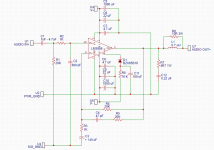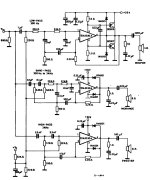Dear All,
I´m building a 3-way speaker with mid range and tweeter path based on seperate LM3886 (XO at 240 and 3700 Hz)
Would it make sense or do any good (stability, ...) to limit the bandwidth of the amps or is this even negative and better to run them in full range?
THX for any thoughts!
Best, Josef
I´m building a 3-way speaker with mid range and tweeter path based on seperate LM3886 (XO at 240 and 3700 Hz)
Would it make sense or do any good (stability, ...) to limit the bandwidth of the amps or is this even negative and better to run them in full range?
THX for any thoughts!
Best, Josef
not sure if reducing the bandwidth of LM3886 via feedback network would actually decrease stability (mininum gain for stability). it could eventually reduce the amp noise, if this is an issue.to limit the bandwidth of the amps or is this even negative and better to run them in full range
you could consider adding a servo with increased high pass frequency. but it probably makes even more sense to add a (big) output cap for the tweeter, to protect it from eventual faulty low frequencies.
That would be problematic. It's easy to see that with a 2nd order high pass at 240Hz built into the feedback (to get overall low pass) the gain will drop below the minimum for stability pretty quick.
Jan
Jan
Jan thanx. Pardon my ignorance, but how would that be easy to see? I not familiar with the LM3886 datasheet (and was too lazy to look that either..) , but is this because the LM is not stable below, say, less than 20dB gain?
Because it is Sunday. A very good day to do little favours to other people, including the lazy ones, now that you still can.
Using a conditional stable amp like the LM3886 as part of the filter is a risky thing. If you look at the internal (summing) nodes of such a filter, signal voltages can be much higher than what you would expect from the outside, and loop gain also varies all over the place especially at the filter cut-off frequencies.
It is not readily apparent that, for instance, the minimum gain requirements of the LM3886 are respected.
If can be done but needs good insight and care.
Jan
It is not readily apparent that, for instance, the minimum gain requirements of the LM3886 are respected.
If can be done but needs good insight and care.
Jan
Thanx for chiming in. Risky: that was my thought too. Related: do TINA or LT Spice indicate (a sort of red flag) stability issues?
No, but it is customary to do a sim run and check for stability. There are several methods, if you're interested there are several threads here on that. Probably the Using LTspice from beginner to advanced is the best and most complete one, but also the longest ;-)Thanx for chiming in. Risky: that was my thought too. Related: do TINA or LT Spice indicate (a sort of red flag) stability issues?
Ask user Mooly.
Jan
You also may have a look at the KiCad/ngspice simulation examples at https://forum.kicad.info/t/simulation-examples-for-kicad-eeschema-ngspice/34443 , including simulation with a Tian probe.
Holger
Holger
With Tina TI, I have experimented with Sallen Key filters with gain.
Using TI 1875 models and 3886.
If you test with a steady signal at a single frequency, stability might not be obvious
I tend to set the internal resistance of the voltage sources around 1.6 ohms not 0
then use function generator to slowly step up input signal
and also slowly step up frequency at low input and high input signals.
Then you start to see stability issues.
I also test at high frequency with square wave.
not only filters but amplifiers in general. You will find stability issues.
As far as filters with 1875 and 3886 when I do frequency sweeps, usually near cutoff it goes unstable.
or at high frequency around 18k it goes unstable. Or near cutoff the gain climb up and clip
when it shouldn't be clipping.
If you just apply a steady signal usually ok. No clipping near cutoff
then with a sweep it randomly clips
sometimes the scope might not even show stability issues, it should be
but the scope might start to crash, and finally simulator gives up and waves convergence errors.
If I test with more " ideal" opamp models for filter applications non of these sweeps cause issues.
Using TI 1875 models and 3886.
If you test with a steady signal at a single frequency, stability might not be obvious
I tend to set the internal resistance of the voltage sources around 1.6 ohms not 0
then use function generator to slowly step up input signal
and also slowly step up frequency at low input and high input signals.
Then you start to see stability issues.
I also test at high frequency with square wave.
not only filters but amplifiers in general. You will find stability issues.
As far as filters with 1875 and 3886 when I do frequency sweeps, usually near cutoff it goes unstable.
or at high frequency around 18k it goes unstable. Or near cutoff the gain climb up and clip
when it shouldn't be clipping.
If you just apply a steady signal usually ok. No clipping near cutoff
then with a sweep it randomly clips
sometimes the scope might not even show stability issues, it should be
but the scope might start to crash, and finally simulator gives up and waves convergence errors.
If I test with more " ideal" opamp models for filter applications non of these sweeps cause issues.
There are some online articles on these issues, it's well-known.
I'll see if I can find any.
Jan
I'll see if I can find any.
Jan
Can we make the general assumption that, as soon as gain is no more uniform -even in the filter passband- but starts to rise "locally", the circuit is locally running out of phase margin and is thus approaching "instability territory"? It is the gain-stage before true oscillation I am referring to.
That would be a very, very general assumption. Especially with feedback with frequency-dependent components, you can easily have the opposite.
And what gain are you talking about? The closed loop gain? In that case it isn't true - look at the LM3886 itself: increasing the closed loop gain around it from the minimum to a higher value improves stability.
This is an area that is very hard to grok without at least some formal training.
Jan
And what gain are you talking about? The closed loop gain? In that case it isn't true - look at the LM3886 itself: increasing the closed loop gain around it from the minimum to a higher value improves stability.
This is an area that is very hard to grok without at least some formal training.
Jan
- Home
- Amplifiers
- Chip Amps
- LM3886 - limited bandwidth for active speaker: does it make sense?

